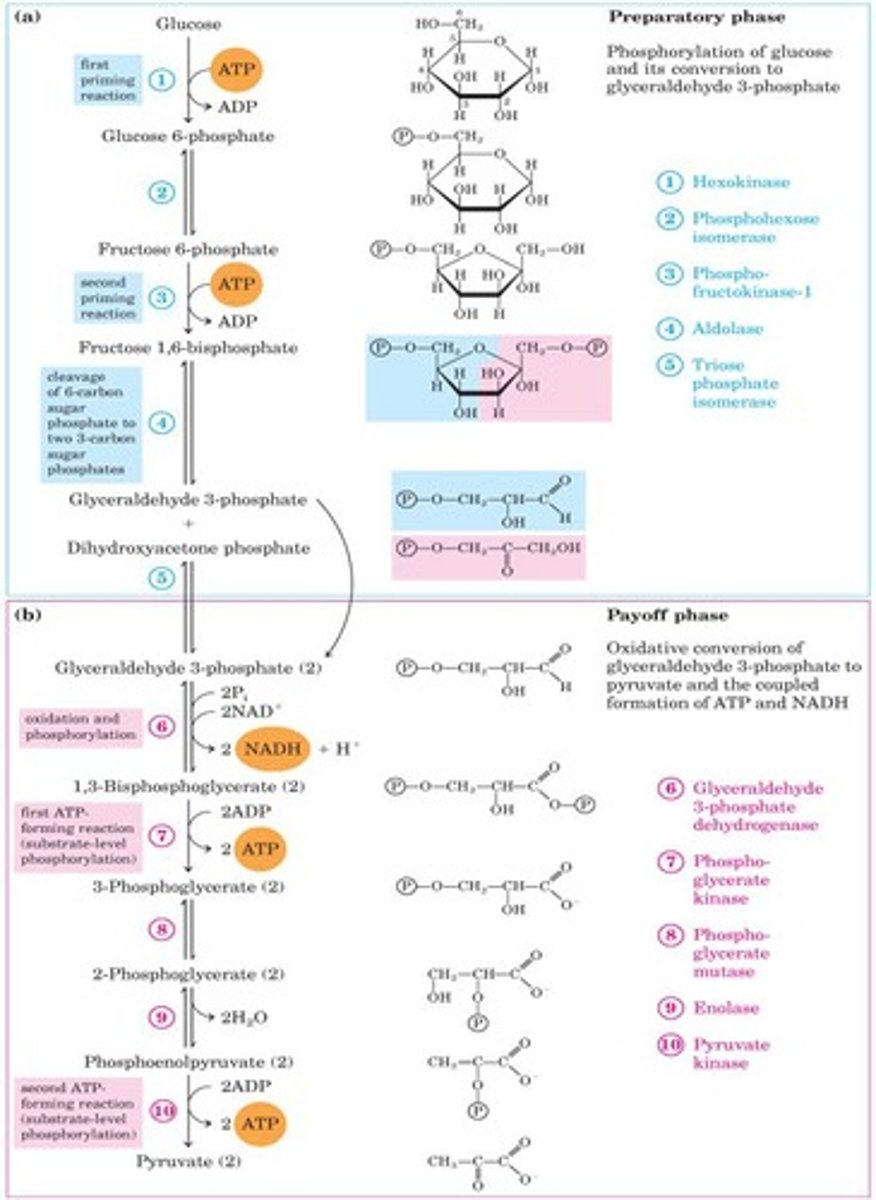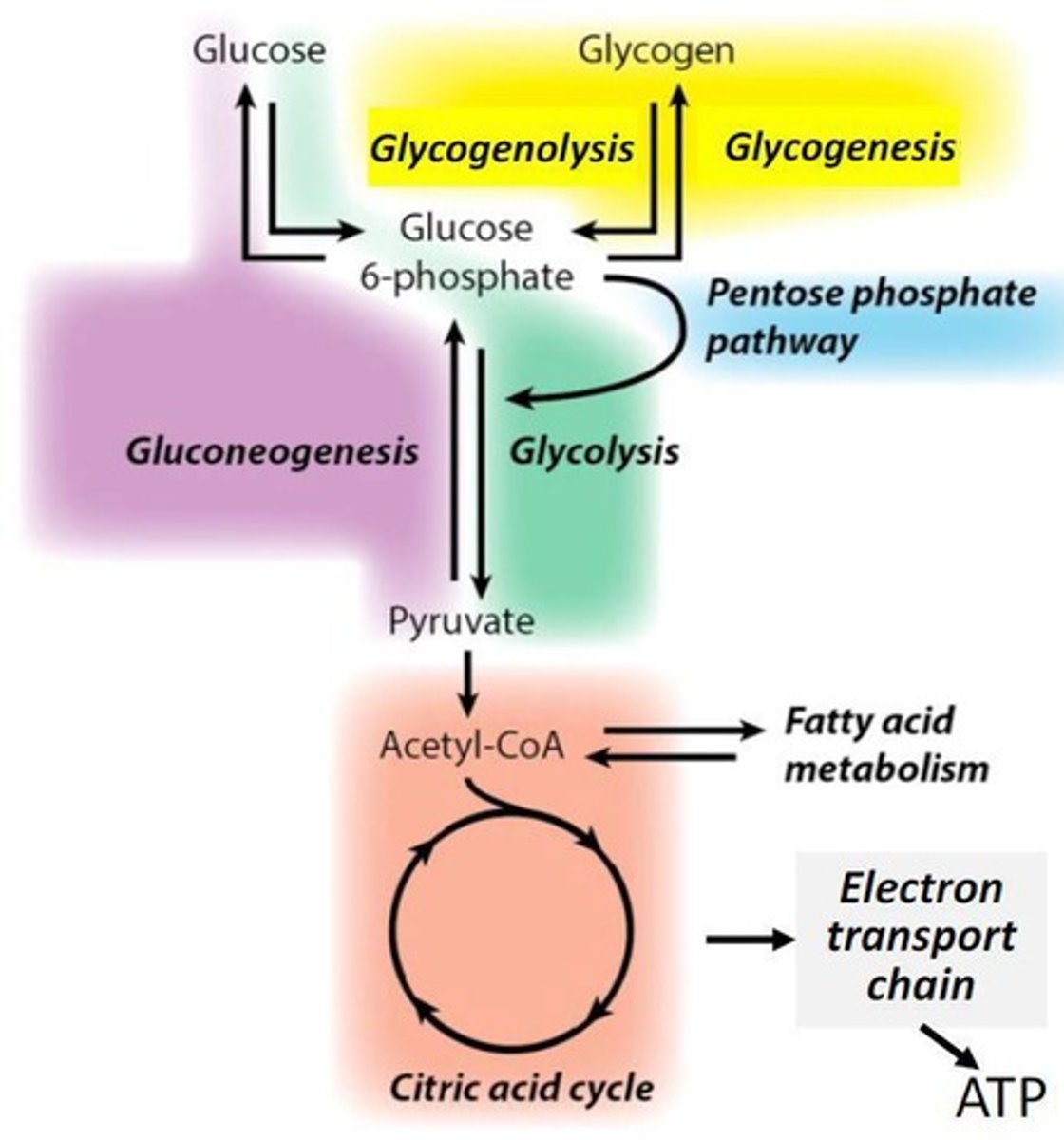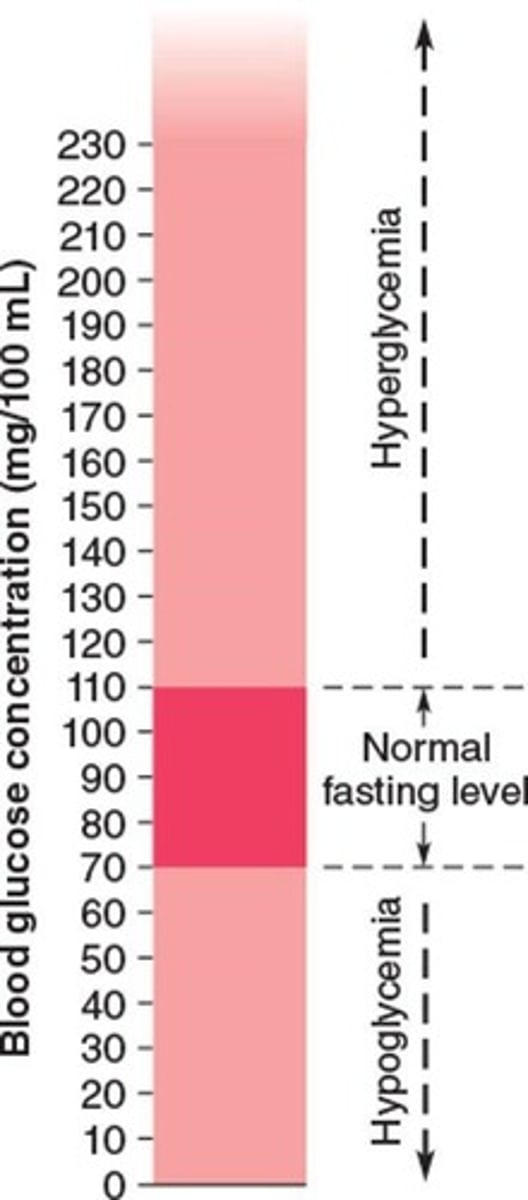Carbohydrate Metabolism Overview
1/55
There's no tags or description
Looks like no tags are added yet.
Name | Mastery | Learn | Test | Matching | Spaced |
|---|
No study sessions yet.
56 Terms
Carbohydrate Metabolism
Biochemical process of breaking down carbohydrates.
Carbohydrate Digestion
Di- and polysaccharides hydrolyzed to monosaccharides.
Blood Glucose Level
Amount of glucose in blood, mg/100 mL.
Hypoglycemia
Lower-than-normal blood sugar level.
Hyperglycemia
Higher-than-normal blood sugar level.
Renal Threshold
Blood sugar level where kidneys can't reabsorb glucose.
Glucosuria
Excretion of glucose in urine due to high blood sugar.
Glycolysis
Glucose catabolized to pyruvate in cytoplasm.

Net Glycolysis Reaction
Glucose + 2ADP + 2NAD+ → 2Pyruvate + 2ATP.

Fates of Pyruvate
Oxidized to acetyl CoA, reduced to lactate or ethanol.
Citric Acid Cycle
Acetyl CoA oxidized to CO2, producing NADH and FADH2.

Regulation of Glycolysis
Controlled by hexokinase, phosphofructokinase, pyruvate kinase.
Feedback Inhibition
Glucose-6-phosphate inhibits hexokinase noncompetitively.
ATP Production from NADH
1 NADH generates 2.5 ATP during oxidative phosphorylation.
ATP Production from FADH2
1 FADH2 generates 1.5 ATP during oxidative phosphorylation.
Oxidative Phosphorylation
ADP converted to ATP via electron transport chain.

Chemiosmotic Hypothesis
Proton gradient drives ATP synthesis in mitochondria.
Glycogenesis
Process of converting glucose to glycogen.
Glycogenolysis
Process of breaking down glycogen to glucose.
Gluconeogenesis
Synthesis of glucose from non-carbohydrate sources.
Cori Cycle
Lactate converted back to glucose in liver.
Aerobic Conditions
Metabolism occurs in the presence of oxygen.
Anaerobic Conditions
Metabolism occurs in the absence of oxygen.
Lactate Fermentation
Conversion of glucose to lactate under anaerobic conditions.
Alcoholic Fermentation
Conversion of glucose to ethanol by microorganisms.
NAD+ Regeneration
Essential for glycolysis to continue after pyruvate processing.
Acetyl CoA
Key molecule entering the citric acid cycle.
GTP Production
One GTP produced per cycle in citric acid cycle.
Electron Transport Chain
Electrons reduce oxygen to water, generating ATP.
Cytochromes
Iron-containing enzymes in the electron transport chain.
Oxidation of Pyruvate
Produces acetyl CoA and CO2 in mitochondria.
Energy Yield from Glucose
Complete oxidation yields approximately 32 ATP.
ATP Yield from Glycolysis
Produces 2 ATP and 2 NADH per glucose.

ATP Yield from Citric Acid Cycle
Generates 2 GTP, 6 NADH, and 2 FADH2.
Complete Oxidation of Glucose
Process yielding 686 kcal/mol from glucose.
ATP Synthesis Energy
Energy produced during ATP synthesis is 234 kcal/mol.
Overall Reaction of Glucose
C6H12O6 + 6O2 + 32ADP + 32Pi → 6CO2 + 32ATP + 38H2O.

Energy Capture Efficiency
Living cells capture 34% of released free energy.
Automobile Engine Efficiency
Engines capture 20-30% of energy from gasoline.
Glycogenesis
Synthesis of glycogen from glucose molecules.
Energy Source for Glycogenesis
Hydrolysis of UTP provides energy for glycogenesis.
Glycogen Storage in Liver
Liver can store 110 g of glycogen.
Glycogen Storage in Muscles
Muscles can store 245 g of glycogen.
Glycogen Synthase
Enzyme forming linkages in glycogen synthesis.
Amylo (1,4-1,6)-trans-glycosylase
Enzyme inserting branch points in glycogen.
Glycogenolysis
Breakdown of glycogen to release glucose.
Glycogen Phosphorylase
Enzyme catalyzing cleavage of glycogen linkages.
Glucose-1-Phosphate
Product of glycogen cleavage by phosphorylase.
Debranching Enzyme
Enzyme hydrolyzing branch linkages in glycogen.
Glucose-6-Phosphate Hydrolysis
Conversion of glucose-6-phosphate to glucose.
Muscle Cell Glycogenolysis
Muscles produce glucose-6-phosphate, not free glucose.
Liver Function in Glycogenolysis
Liver releases glucose to maintain blood glucose levels.

Gluconeogenesis
Synthesis of glucose from noncarbohydrate sources.
Cori Cycle
Process converting lactate to glucose between muscle and liver.
Insulin Function
Hormone enhancing glucose absorption and glycogen synthesis.
Glucagon Function
Hormone increasing blood glucose and glycogen breakdown.